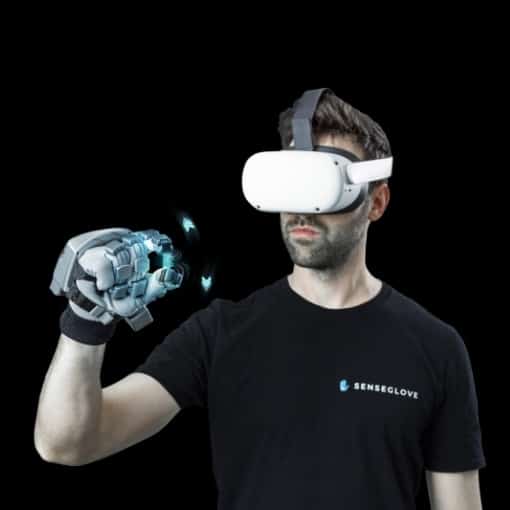The Uses of VR in Research and Education
Virtual Reality (VR) has emerged as one of the most promising new technologies in recent years. In fact, the number of VR users is projected to reach 65.9 million by 2023. VR allows users to experience a simulated, three-dimensional environment, and its potential uses are vast. It is used in a variety of fields, including research and education.
VR offers a unique perspective that can be used to probe the unknown, gain new insights into scientific phenomena, and provide immersive educational experiences. This blog post will discuss the applications and benefits of haptics VR solutions in research and education.

Haptics and VR
Haptics is the study of how humans interact with and perceive their surroundings through touch. This type of technology can be used to create more realistic training simulations, educational experiences, and research investigations. It covers a wide range of topics, from the mechanics of the sense of touch to the design of haptic interfaces. Haptics is a growing field of research, with applications in virtual reality such as haptic gloves and other haptic feedback devices.
Breakthroughs in haptic technology are providing new ways for researchers and educators to interact with virtual environments. The use of haptic gloves, for example, can allow users to feel the size and density of virtual objects and receive feedback based on their tactile interactions.
Haptic Gloves in VR Simulation
Haptic gloves make VR simulation even more immersive and engaging. A haptic glove is a force-feedback device integrated with motors, sensors and actuators. When the user encounters an object in VR, the force-feedback system restricts the movement of your fingers in response to a virtual object. This force feedback allows the user to experience an object’s size and density, which simulates the sensation of holding and using actual tools or equipment.
By using haptic gloves or other devices, it’s possible to provide haptic feedback that allows users to interact with virtual objects as if they were real. This can enhance the realism of simulations and make them more useful for VR simulation purposes.
Haptics can be particularly helpful for students studying anatomy or other subjects requiring a hands-on approach. In addition, haptics research provides new insights into how the sense of touch works and its role in human learning and development.

Applications of VR in Research and Education
Researchers are finding that VR simulations can provide a realistic and interactive experience that can be used for various purposes, such as data collection, training, and experimentation. For example, VR can be used to study human behaviour in a controlled environment and understand how diseases spread.
In education, VR can provide students with hands-on experience in various fields, such as medicine or engineering. It can also create simulations of real-world environments, which students can study in a controlled setting. This type of immersive learning is more effective than traditional methods, such as getting information from a textbook.
VR is also used in medical research. Learners can practise handling. On the other hand, patients recovering from brain or nerve damage can slowly ease themselves into day-to-day tasks by using VR gloves to relearn movements.
We have seen these benefits in action in the following case studies:
Remote Operations
The Netherlands Organisation for Applied Scientific Research has created a system using SenseGlove DK1 that enables the operator to interact with remote objects miles away. Further development could help military personnel and emergency responders safely perform dangerous tasks without being physically present.
Artefact Handling
Anyone who has ever handled an ancient artefact knows that even the slightest touch can cause irreversible damage. To prevent this, museum staff must take great care when handling any artefacts, using gloves, cotton buds and other tools to avoid direct contact. However, this can make it challenging to get a clear idea of the artefact’s shape and surface texture.
Haptics could help solve this problem. By allowing users to see a virtual representation of the artefact, haptic gloves make it possible to examine and physically feel an artefact without ever touching it.
This could significantly impact how history is taught in schools and universities. Students would be able to handle virtual replicas of ancient artefacts, getting a much clearer sense of their form and structure.
Staffordshire University used SenseGlove DK1 to interact with original ceramic artefacts. The project allowed its members to handle digital replicas and get complete contextual information about them.
What’s to Come
It is no secret that technology has drastically changed how we live and interact with the world. VR has the potential to revolutionise research and education by providing immersive, realistic simulations that allow people to explore new environments and learn in ways never before possible through haptics.
Discover how you can apply haptic gloves to your processes, VR training, simulations, and research endeavors by reaching out to SenseGlove today


